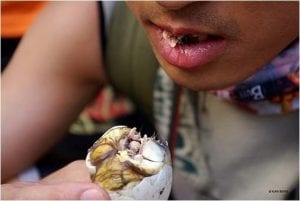The Balut: A UCF Professor’s Rite of Passage
 Being paid to talk about food is a dream job for some, for one UCF professor it became reality by stepping into the streets of the Philippines and cracking open a fertilized duck egg.
Being paid to talk about food is a dream job for some, for one UCF professor it became reality by stepping into the streets of the Philippines and cracking open a fertilized duck egg.
Dr. Ty Matejowsky, of the Anthropology Department, won the 2014 Belasco Prize for Scholarly Excellence presented by the Association for the Study of Food and Society. Dr. Matejowsky was presented with a $300 cash stipend to go along with the award.
“I was pleasantly surprised,” Matejowsky said. “To get some financial compensation to go along with the research.”
The research paper Matejowsky submitted called “The Incredible, Edible Balut: Ethnographic Perspectives on the Philippines’ Favorite Liminal Food” focused on a critical analysis of the popular Filipino cuisine.
In the summary of his article he stated that “these popular Filipino street snacks comprised of partially incubated duck eggs with a decidedly liminal character have become increasingly familiar to Westerners over recent years thanks to their most sensationalized depictions in various genres of popular culture.”
Liminal, meaning in-between or transitional according to Merriam-Webster Dictionary, refers to the fertilized duck egg in its 18-day-old stage developing from being an embryo to a hatched chick.
According to Matejowsky the boiled fertilized eggs consist of “equal parts warmish soupy fluid, solid yellow yolks and gristly embryonic ducklings.”
Although he had been traveling to the Philippines since 1994 he did not take the plunge to try the local dish until 2010. Being pleasantly surprised, he described the taste as similar to hardboiled eggs but the texture varies. What may throw some bold eaters off is the noticeable taste of bones and embryo.
The liminal nature of balut gives the fertilized duck eggs value that locals and foreigners recognize. It also differentiates them from other items street vendors sell at the neighborhood level.
Eating this dish shows the local people that you are open to their culture and appreciate it. Consuming the egg is considered a rite of passage to the Philippine people, according to Matejowsky.
“Arguably, balut’s symbolic value is becoming increasingly divorced from its homegrown origins following the delicacies’ recent appropriation by the Western cultural industry,” Matejowsky said.
The food has been featured in many TV shows such as “Fear Factor” and “Survivor”, to name a couple. The symbolism may be lost as it transitions onto Western tables, but it may even be changing in the Philippines.
According to CNN the dish is reporting mixed reviews among the newer generations of Filipinos. If children did not grow up eating it then they are more likely to have an aversion toward it.
“Maybe [I] wouldn’t advise anyone to eat it, but always be willing to have an open mind because it isn’t always as bad as it seems, sometimes,” Matejowsky said.
While he may not recommend it to everyone, one group openly sought it out. Known for their lack of comfort zone with food, the Gastronauts is the largest club for adventurous eaters, based in New York City, San Francisco and Los Angeles. With a membership of roughly 1,300 people, they do not shy away from strange meals.
The group based out of San Francisco decided to have a Filipino cuisine night in March, with fertilized egg on the menu.
On the other side of the country, in New York City, an annual balut eating contest is held each August. The Metro reported that the 2013 contest winner consumed 27 balut in five minutes. The same man had won the previous year with a total of 18 balut consumed in the same amount of time.
The contrast between the respect for balut in the Philippines and the novelty of the dish in the west is clear. Matejowsky stated in his studies that the difference between the local and global views about balut reflect how the ideas of local foods are re-imagined on a global scale.


